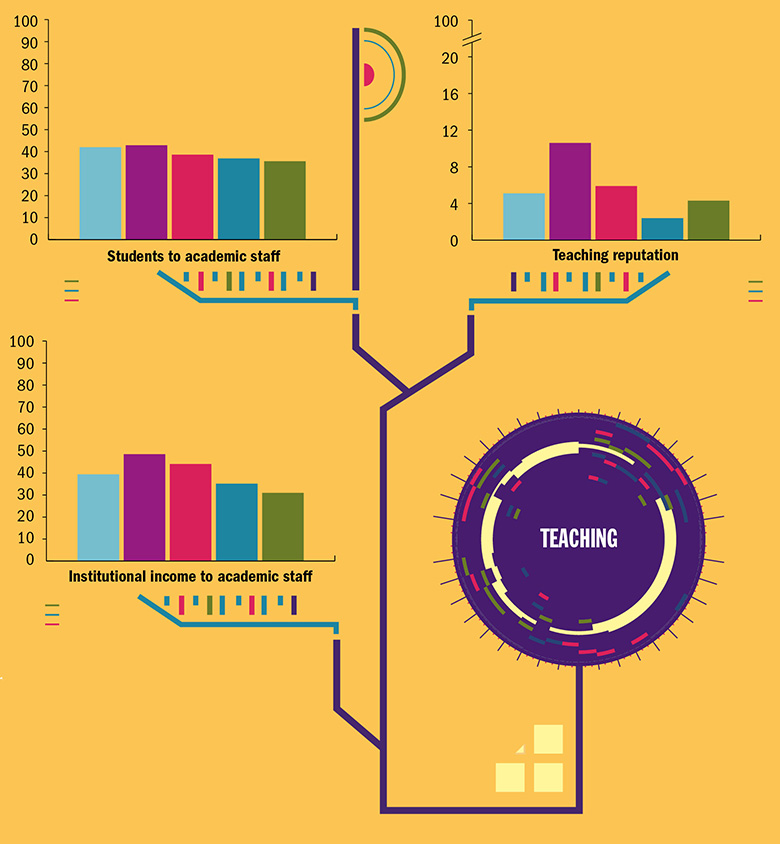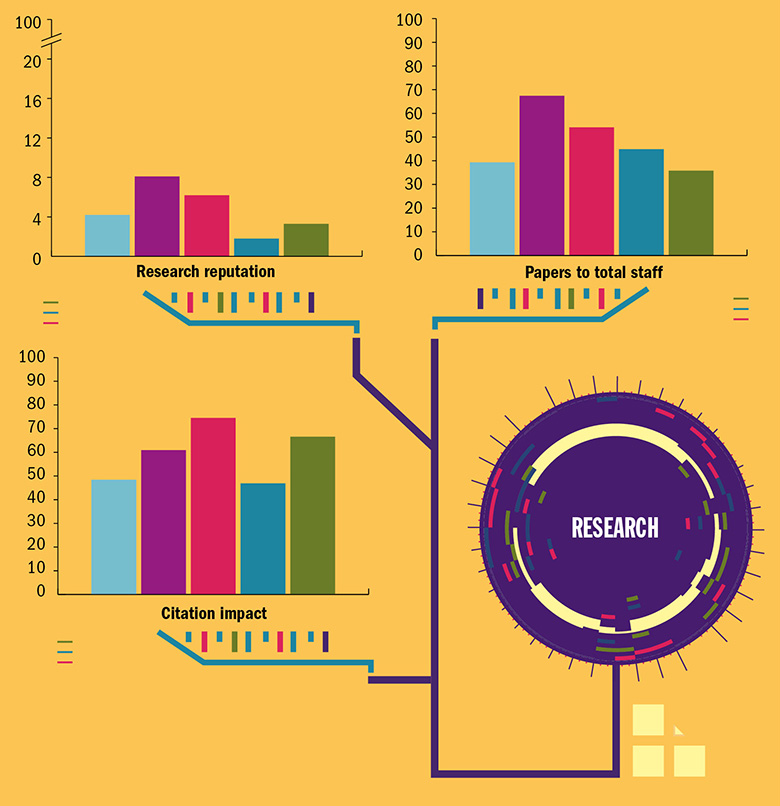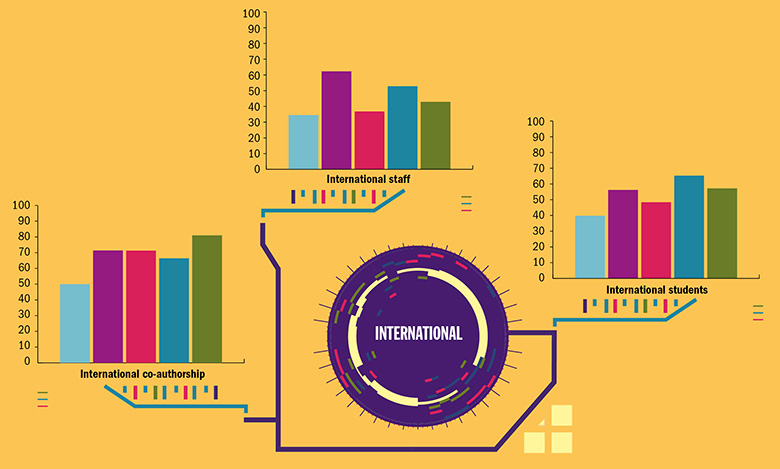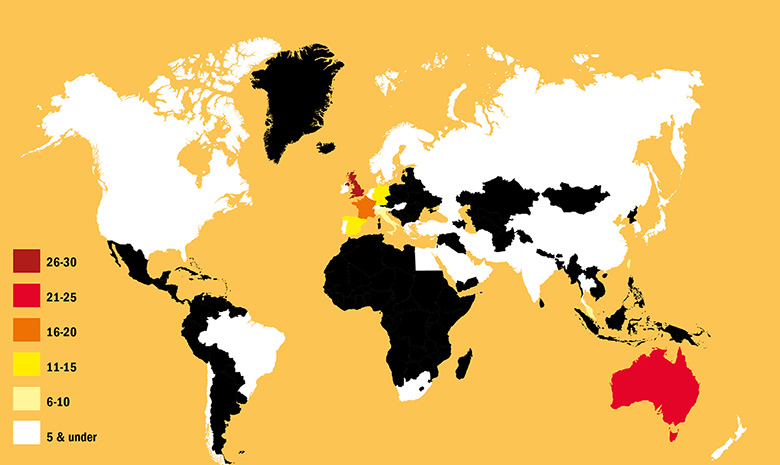Browse the full list of the top 200 institutions in this year's rankings
The world’s youngest universities outperform their older counterparts when it comes to attracting overseas students and publishing international research, according to data used in the 2017 Times Higher Education Young University Rankings.
While older institutions tend to be richer and have stronger reputations in teaching and research, THE data show that young universities excel when it comes to internationalisation.
Institutions that were founded from 2000 to the present day (“Millennials”) produced the highest proportion of internationally co-authored research, when compared with universities founded during other periods since the Second World War and the full list of institutions in the latest THE World University Rankings, which have a median age of 91.
Meanwhile, universities founded between 1986 and 1999 (“Generation Y”) attracted the highest proportions of international students on average, followed by the Millennials cohort.
The findings are based on the median scores for universities of different age groups that feature in the World University Rankings. As well as the Millennials and Generation Y cohorts, the analysis calculated the median scores for “Generation X” (1967-1985) and “Golden Age” (1945-1966) universities, as well as for the full 980-strong list. However, some of the Millennial institutions, such as the Karlsruhe Institute of Technology and the University of Antwerp, were established by mergers of older institutions.
- A growing concern sprouts new branches
- 14 mistakes new universities make
- Growth factors and future prospects
- Luxembourg – powering a nation
- Welcoming the reinvigorators
In the Millennials group, the University of Luxembourg (founded in 2003) and Saudi Arabia’s Alfaisal University (2002) achieved the highest scores for internationalisation, which encompasses metrics on the proportion of international students, staff and research.
The results may reflect the priorities of recently founded universities.
Attila Brungs, vice-chancellor of the University of Technology, Sydney, which is fifth for internationalisation in the Generation Y group, said that the institution focuses on “preparing our students to be global professionals”. More than one-third (35 per cent) of students at the institution come from abroad, while a similar proportion of domestic students spend time studying overseas, he said.
The data also show that Generation X universities and the Millennials achieved the greatest scores for citation impact on average.
Margarita Arboix, rector of the Autonomous University of Barcelona, which comes eighth among Generation X institutions when ordered by citations, said that research at the institution “has a remarkable multidisciplinary and international nature”.
- Golden Age universities
- Top 50 Generation X universities
- Top 50 Generation Y universities
- Millennial universities
For example, the university’s strategic research communities form networks of researchers across disciplines in order to conduct research on global challenges, such as smart cities, cultural heritage and mental health.
École Polytechnique Fédérale de Lausanne (1969) leads the Generation X group when it comes to citations.
The Swiss university is also top overall for the third year in a row in the THE Young University Rankings, which lists the world’s best 200 universities aged 50 or under.
Overall, the UK is the most-represented nation in the table with 27 universities, headed by the University of Dundee in 16th place, followed by Australia with 23 institutions.
The ranking is based on the same 13 performance indicators as THE’s World University Rankings, but academic reputation is given a lower weighting.
Young University Rankings 2017: top 10
|
Young University Rank 2017 |
Young University Rank 2016 |
World University Rank 2016-17 |
Institution |
Country |
Year founded |
|
1 |
1 |
=30 |
Switzerland |
1969 |
|
|
2 |
3 |
49 |
Hong Kong University of Science and Technology |
Hong Kong |
1991 |
|
3 |
2 |
54 |
Nanyang Technological University |
Singapore |
1991 |
|
4 |
5 |
=104 |
South Korea |
1986 |
|
|
5 |
6 |
=89 |
South Korea |
1971 |
|
|
6 |
4 |
94 |
Netherlands |
1976 |
|
|
7 |
20 |
119 |
Hong Kong |
1984 |
|
|
8 |
13 |
=135 |
Germany |
1967 |
|
|
=9 |
8 |
=144 |
Germany |
2009 |
|
|
=9 |
10 |
=190 |
Scuola Superiore Sant’Anna |
Italy |
1987 |
Browse the full list of the top 200 institutions in this year's rankings

Masters of reinvention
Agile fledgling campuses relish experimenting and radiate interdisciplinarity
When Barack Obama delivered his farewell address during his final fortnight as US president earlier this year, he cited America’s age as one of several attributes that make the country “exceptional”.
“Our youth, our drive, our diversity and openness, our boundless capacity for risk and reinvention means that the future should be ours,” he said.
The same could be said for many of the universities that feature in the Times Higher Education Young University Rankings 2017 – the world’s 200 best universities that are 50 years old or younger.
When compared with the traditional and more established higher education institutions, these young universities are characterised by their experimental and flexible nature, their interdisciplinarity, their openness to new ideas, and their willingness to constantly reinvent themselves.
Take Bielefeld University, ranked in 22nd place.
Gerhard Sagerer, its rector, says that faculties at the university are small and cover single subjects such as maths and physics rather than large discipline areas, which makes it easier for academics in different departments to communicate with one another. This is supported by the physical structure of the university, which is made up of just one building. At 300m long and 200m wide, it takes a maximum of three minutes to walk from one end to the other, he says.
“Interdisciplinarity was implemented in the DNA of Bielefeld University,” says Sagerer.
View this year's Young University Rankings methodology in full
The institution is currently undergoing a refurbishment that will see three or four additional buildings erected, but it will still take only a maximum of five minutes for academics or students to walk between any two points, he notes.
Bielefeld is one of 11 German universities in the top 200 of the Young University Rankings and one of four in the elite top 25, joining Ulm University in 8th place, the Karlsruhe Institute of Technology in joint 9th place and the University of Duisburg-Essen in joint 13th place.
Other countries in continental Europe also feature heavily in the list; France has 16 institutions, led by Pierre and Marie Curie University in 12th place; Spain has 15, headed by Pompeu Fabra University in 17th place; while Italy has 10, topped by Scuola Superiore Sant’Anna in joint ninth place.
But, overall, the UK is the most represented nation in the table, with 27 universities, closely followed by Australia with 23.
The ranking, which includes 200 institutions for the first time (up from 150 last year), is topped by Switzerland’s sole representative, École Polytechnique Fédérale de Lausanne, for the third year in a row.
In fact, despite the inherent dynamism of the list, which annually excludes universities when they reach their 51st birthday, the remainder of the top six features the same institutions as last year, albeit in a slightly different order: Hong Kong University of Science and Technology and Nanyang Technological University swap places to claim second and third place, respectively, while Pohang University of Science and Technology climbs to fourth, Korea Advanced Institute of Science and Technology (KAIST) jumps to fifth, and Maastricht University drops to sixth.
Martin Vetterli, who became president of EPFL this year, says that while the university is “quite young” at 48 years old it “has strong roots in the country”; it started as the engineering department of Lausanne University, transforming into the federal institution in 1969, meaning that 55 “renowned professors were already on board” from the beginning, he explains.
“Their number grew very fast,” he notes. “Important achievements in the early years, thanks to transversal projects with strong industrial focus, confirmed [that EPFL] deserved [its] high reputation, first locally, then internationally.
“More recently, successes in international research competitions, as well as numerous collaborations with partner universities all over the world, made EPFL highly visible on a global level.”

Unlike other Swiss universities, with the exception of ETH Zurich – Swiss Federal Institute of Technology Zurich, EPFL is directly controlled by the federal government, a factor that Vetterli cites as a big advantage.
“Our federal parliament is aware of the need for high-quality technical universities in the country, whose financial needs go beyond what the local authorities could afford,” he says.
Margarita Arboix, rector of the Autonomous University of Barcelona, which claims 18th place in the ranking, says that at 49 years old, the institution is “very close to reaching the half-century mark”, which means that it “already has a good amount of experience in teaching and research”, unlike some other young universities.
Its academic and administrative management structures are also “more flexible to make changes and adapt to any necessary innovations” than some other older institutions, she adds.
“This is something we view as an opportunity in comparison with traditional universities,” she explains.
Search our database for the latest global university jobs
But youth can have its drawbacks in higher education, she warns.
The university is “too young to have a good network of alumni and partnerships” or “a good system of private crowdfunding”, which makes it difficult to obtain additional resources for teaching and research, she says.
Bielefeld’s Sagerer adds that while his university is very attractive to young researchers, who are often interested in working in a “more dynamic environment” where there is a chance to “develop new ideas within new structures”, it can be difficult to retain older professors, who are drawn to the more traditional universities.
For Attila Brungs, vice-chancellor of the University of Technology, Sydney, Australia’s top young university in 15th place, aspects that began as disadvantages for the university in its infancy have become advantages.
For example, the institution was “relatively land poor and asset poor” after its establishment in “what was at one stage a less salubrious part of Sydney” in 1988.
But the lack of vast amounts of land means that the institution is now “very porous” and “indelibly linked into the community”, with companies situated in the lower levels of all its buildings.
Browse Times Higher Education’s full portfolio of university rankings
Meanwhile, the dearth of big lecture theatres is now also an advantage, he says, given that learning today is much more interactive.
The university is undergoing an A$1 billion (£617 million) refurbishment of the campus, which has already led to the creation of small, collaborative, technology-enabled learning spaces for students, says Brungs.
Like several universities in this ranking, UTS has the word “technology” in its title. But, while many other technology universities focus on science and engineering disciplines, UTS also offers business, health, arts and social science subjects, says Brungs.
The word “technology” refers to an “underpinning theme” across these courses, which focus on the way that technology can be used to change society in each subject area, he explains.
“We’ve been running sandwich courses for engineers for the longest [time of any university] in Australia and we have the highest number of students going on internship place[ments],” he says.
“We always try to prepare our students to lead the profession as soon as they get out there.”
So what are the main benefits of being a young university?
Brungs points to two main advantages at UTS; its lack of silos, which fosters transdisciplinary teaching and research, and its dynamism, which means that it is constantly re-evaluating itself.
For example, the university has recently refreshed its pedagogy by adopting a flipped classroom model, in which students access material online and classes are devoted to interactive learning.
The university has made big changes in “just a couple of years,” says Brungs, “because we’re young and because we don’t have long traditions that we have to worry about”.
“That gives us a great advantage. We can see what society and the economy needs and make the changes relatively quickly,” he adds.
“I know many older universities that are still writing white papers and thinking about how the hell they’re going to change.”
Youth movements
These graphs show how groups of universities of different ages perform on nine separate metrics in the World University Rankings. Each chart represents one of the metrics (arranged into three broad areas: teaching, research and international) and the median scores for each age group as well as for the World University Rankings overall.
The “Golden Age” (1945-1966) universities – the most established on the global stage – perform strongly across all the metrics, but particularly on those related to teaching, research reputation and research productivity. Some of the scores for “Generation X” (1967-1985) seem to suggest the start of a correlation between age and performance, and this group has the best median score for citation impact. However, it does less well on measures related to international outlook, and it has the worst showing on ratios of overseas staff and students. Interestingly, the newest universities (those in the “Generation Y” (1986-1999) and the “Millennial” (2000-present) groups) excel on the metrics related to internationalisation, perhaps because their youth has allowed them to align their missions to the recent globalisation of higher education.
There are also some surprising results. The Millennial universities outperform every other group bar Generation X on citation impact (perhaps a result of their stellar performance on international co-authorship, which has been linked to citation impact), although it is worth noting that a number of Millennials were established by mergers of older institutions.
Key




Countries and number of institutions represented in the top 200

Register to continue
Why register?
- Registration is free and only takes a moment
- Once registered, you can read 3 articles a month
- Sign up for our newsletter
Subscribe
Or subscribe for unlimited access to:
- Unlimited access to news, views, insights & reviews
- Digital editions
- Digital access to THE’s university and college rankings analysis
Already registered or a current subscriber?








